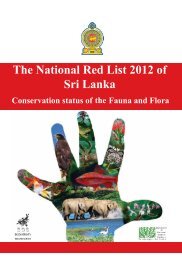English - Convention on Biological Diversity
English - Convention on Biological Diversity
English - Convention on Biological Diversity
You also want an ePaper? Increase the reach of your titles
YUMPU automatically turns print PDFs into web optimized ePapers that Google loves.
.2.1 Nati<strong>on</strong>al Wildlife PolicyThe Nati<strong>on</strong>al Wildlife Policy of 1990 was prepared in resp<strong>on</strong>se to the Nati<strong>on</strong>al C<strong>on</strong>servati<strong>on</strong> Strategy of 1988. Theoverall translati<strong>on</strong> of the previous Wildlife Policy into acti<strong>on</strong> was weak. The current Nati<strong>on</strong>al Policy <strong>on</strong> WildlifeC<strong>on</strong>servati<strong>on</strong> (of 2000) has been expanded to include policy needs that resp<strong>on</strong>d to the evolving needs of SriLankan society and the mandate c<strong>on</strong>ferred as obligati<strong>on</strong>s under the <str<strong>on</strong>g>C<strong>on</strong>venti<strong>on</strong></str<strong>on</strong>g> <strong>on</strong> <strong>Biological</strong> <strong>Diversity</strong>. TheNati<strong>on</strong>al Wildlife Policy of 2000 recognized the need for appropriate and effective management of PAs, takinginto c<strong>on</strong>siderati<strong>on</strong> the needs of local communities and for providing support to wildlife resource managers byway of reorientati<strong>on</strong>, strengthening and decentralizati<strong>on</strong> of their instituti<strong>on</strong>s. This policy renews statecommitment to c<strong>on</strong>serve wildlife resources for the benefit of present and future generati<strong>on</strong>s. It also recognisesthe need to link activities, interests and perspectives of the people who use and benefit from wildlife resourceswith those of professi<strong>on</strong>al wildlife managers and scientists. The policy c<strong>on</strong>curs with the targets of the PoWPA byits decree to:• identify, classify manage and m<strong>on</strong>itor all protected areas based <strong>on</strong> appropriate scientific studies and agreedcriteria;• z<strong>on</strong>e and manage all protected areas according to approved management plans, taking into account thec<strong>on</strong>text of their surrounding landscapes, and the ecological, social and ec<strong>on</strong>omics links between natural andhuman systems;• adopt ecosystem-based management, including the eradicati<strong>on</strong> of alien and invasive species where possibleafter c<strong>on</strong>siderati<strong>on</strong> of the envir<strong>on</strong>mental impacts of these interventi<strong>on</strong>s; and to encourage sustainabledevelopment of communities living around protected areas, by c<strong>on</strong>sulting them in decisi<strong>on</strong> making, enablingtheir active participate in PA management and providing direct benefits from the management of protectedareas; and• facilitate eco-tourism in protected areas, to the extent that it provides benefits to local people and doesnot damage the ecosystem c<strong>on</strong>cerned.The secti<strong>on</strong> <strong>on</strong> Protected Area management of this policy specifically recognises the importance of protectingrepresentative samples of all terrestrial, coastal and marine ecosystems and sites of special scientific interestsuch as Wet Z<strong>on</strong>e forests, and obtaining the support of local people in protected area management. The policyalso articulates the need for a decentralised administrati<strong>on</strong> that enhances the flow of benefits from protectedareas to those living in their vicinity..2.1 The Nati<strong>on</strong>al Forestry Sector Master PlanThe Forestry Sector Master Plan (FSMP) of 1995 was prepared to take forward the Nati<strong>on</strong>al Forest Policy of 1995during the period 1995 to 2020. This plan was developed with special emphasis <strong>on</strong> the c<strong>on</strong>servati<strong>on</strong> ofbiodiversity in the forest and wildlife sub-sectors, and has direct relevance for implementati<strong>on</strong> of the PoWPA.While the management of PAs under the Department of Wildlife C<strong>on</strong>servati<strong>on</strong> has not followed the FSMP, theForest Department follows the strategy outlined in the FSMP for management of its reserves. Accordingly,forests under the jurisdicti<strong>on</strong> of the Forest Department will be reclassified, rehabilitated and placed under fourmanagement systems for: (a) strict c<strong>on</strong>servati<strong>on</strong>; (b) n<strong>on</strong>-extractive use such as research and tourism withc<strong>on</strong>trolled collecti<strong>on</strong> of n<strong>on</strong>-wood resources; (c) management of multiple use forests for sustainable producti<strong>on</strong>of wood, and (d) management of forests with community participati<strong>on</strong> to meet the needs of local people (MALF,1995). A significant feature of the FSMP is that it advocates a re-orientati<strong>on</strong> of the traditi<strong>on</strong>al approach of bothForest and Wildlife C<strong>on</strong>servati<strong>on</strong> Departments promoting the involvement of local communities in ProtectedArea Management..2.1 The Nati<strong>on</strong>al Envir<strong>on</strong>mental Acti<strong>on</strong> Plan 0f 2003The current NEAP is termed “Caring for The Envir<strong>on</strong>ment: Nati<strong>on</strong>al Agenda for SustainableDevelopment 2003 - 2007” (CFE). This c<strong>on</strong>tains the Nati<strong>on</strong>al Envir<strong>on</strong>mental Policy of 2003, development linkedenvir<strong>on</strong>mental strategies for implementing the policy, and a comprehensive set of acti<strong>on</strong>s for managing theenvir<strong>on</strong>ment so as to make the development process sustainable. Development is perceived with the activeinvolvement of NGOs and business sector to work with the government sector at both nati<strong>on</strong>al and provinciallevels. The CFE takes into c<strong>on</strong>siderati<strong>on</strong> that individual ministries have their own development strategies andacti<strong>on</strong> plans, although they have various envir<strong>on</strong>mental dimensi<strong>on</strong>s according to their mandates.Fourth Nati<strong>on</strong>al Report to the CBD: Sri Lanka Appendix IIIxii














